by Jim Howell
Summary: To determine what landscapes need in order to remain healthy, we need to consider an area's biological productivity as well as its degree of brittleness.
Jim Howell and his wife Daniela Ibarra-Howell run tours of holistically managed farms around the world. |
As I work and travel around the world, I constantly ask myself where I am on the brittleness scale. (Brittleness measures how much seasonal dryness an area experiences, and is independent of total rainfall.) I look at all the things Allan Savory always emphasizes to try and figure it out -- things like how plant material is breaking down, distance between perennial grass plants, amount of bare ground in areas that I know have rested for years. etc.
Over time I've realized that there are lots of different types of forests, grasslands, steppes and savannas, and I've struggled with where they all fit on the brittleness scale. It seemed to me like there were just too many different types of environments to fit on one linear ten point scale. Allan would tell me it doesn't matter exactly where you lie on the scale; what's important is to know if you lie toward the non-brittle end, in the middle somewhere, or at the high end. Knowing where you are is important since it tells us the responses we can expect as we apply the tools of grazing/recovery, animal impact, and rest. Nonetheless, even with this help from Allan, I still struggled, because I realized there were drastically different environments within each of those three ranges of brittleness. Through experience I am learning that the application of tools has to vary across these distinct environments, even though they lie at similar points on the brittleness scale.
Jim Howell
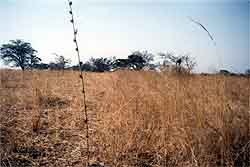 Dormant season in Zimbabwe, a seasonally humid brittle environment. Grazed area at left separated from ungrazed area with a single strand electric wire. Jim Howell
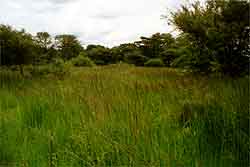 Same area during the growing season. Yearly rainfall averages 890 mm (35"). |
Seasonally humid brittle environments
When I first went to Zimbabwe, it was the end of the dry season. I couldn't believe how bleak it was. What grass that wasn't burnt was gray and oxidizing and there wasn't a leaf on a single tree. When I returned the next year during the rainy season, it was hard to believe that bleakness had ever existed. Everything felt incredibly non-brittle in the middle of the growing season -- lots of atmospheric humidity, torrential downpours almost every afternoon, plants of every kind growing at explosive growth rates, lots of bugs in every nook and cranny, lots of biological decay taking place. It was nothing like any brittle environment I had ever been in, which up to that point had primarily been in arid environments in the western US. Nonetheless, it was still highly brittle. For about 8 months, the total lack of humidity made sure of that. Overrest leads to an overgrown mass of oxidizing, moribund plants (often up to 2-3 m [7-10 feet] tall), a thick mature soil cap (crust), gradually advancing bare ground, and poorly functioning ecosystem processes in general, and all these negative things develop quickly. With such favorable conditions during the growing season, abundant plant material accumulates rapidly, and heavy rains create an algae-covered cap quickly on exposed soil. If those plants and soils aren't disturbed during the following dormant season, they are a major liability when the next growing season arrives.Joy Livingwell
 Arid brittle environment damaged by poor management. This area used to grow stirrup-high grass on 80-150 mm (4-6") annual rain. Destocked range, Nevada, U.S.A.
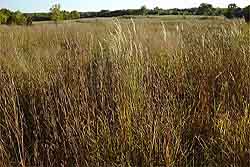 Tall grass prairie in central Kansas, U.S.A., a high productivity, semi-brittle area where rainfall averages 740 mm (29 in.) and grass grows head-high. 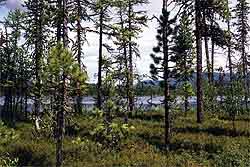 Nonbrittle taiga in Siberia. A short, cool growing season allows taiga regions to stay damp with precipitation of 300-500 mm (11-20"), most falling as snow. Much water runs off in spring before the soil surface thaws. A permafrost layer lingers year-round. 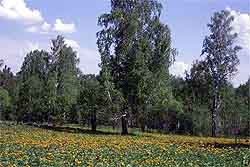 Nonbrittle silver birch forest in Siberia. |
Arid brittle environments
In arid brittle environments, on the other hand, where precipitation is scant and erratic, I gradually realized that this overrested condition might take years to develop. Without periodic physical disturbance, it eventually will develop. But because of the precipitation pattern, it might take several good rainfall years before growth builds up to the point where it burdens the plant, and soils develop a mature cap.
Semi-brittle environments
We can see the same sort of diversity of environments as we move down to the mid range and non-brittle environments. Mid range environments can vary from temperate and subtropical tall grass prairies or park woodlands, to mid grass prairies, to tundra or alpine grasslands. Except during the coldest months or during dry spells, some biological decay usually is taking place. Nonetheless, there tends to be a net buildup of material over the course of a biological year, which includes the growing and dormant seasons, so well-managed large herbivores can greatly increase the effectiveness of the ecosystem processes. The details of management, however, will vary significantly between the tall grass prairie of eastern Oklahoma and the cold tundra in northern Alaska.Non-brittle environments
At the non-brittle end of the scale, environments can range from tropical rainforests to subarctic coniferous taiga forest. Both environments are very non-brittle because the vast majority of decay takes place through microbial action or insect herbivory, and because long-term rest results in the healthiest ecosystem processes and greatest biodiversity. In the subarctic forests, very little decay will take place in the winter, but because summers are constantly humid, all dead plant material eventually breaks down biologically. Also, because of the cold winters and the short growing seasons, growth rates of trees are very slow. In a tropical rainforest, high levels of growth and decay take place every day all year long. So, again, even though both environments are non-brittle, if we are actively managing tropical rainforests or taiga forests, the details of that management must vary due to their inherent differences.Brittleness-productivity scale
I've tried to display all this on a greatly oversimplified but I think useful graph (see below). Instead of describing environments as lying somewhere on a linear scale, I've added a vertical dimension. As I thought about the differences between seasonally humid but brittle savannas and arid steppes or deserts, I realized a huge difference was the amount of organic matter potentially produced per year. I realized the same applied when comparing that tall grass prairie in Oklahoma to the Alaskan tundra or the high mountain meadows on my family's ranch in Colorado. In non-brittle forests, again we see that a tropical rainforest captures a lot more sunshine over the course of a year than a subarctic coniferous forest. So the vertical scale on the left represents inherent annual productive capacity of an environment.Brittleness-Productivity scale
| Non-brittle | Semi-brittle | Brittle | |
|---|---|---|---|
| High annual production | Tropical rainforests | Subtropical and temperate tall-grass prairies | High-rainfall tropical savannas |
| Temperate rainforests | Mid-rainfall tropical savannas | ||
| Medium annual production | Mild temperate forests | Mild and cold temperate mid-grass prairies | Low-rainfall tropical savannas |
| Cold temperate forests | Mild and cold temperate steppe grasslands and shrublands | ||
| Low annual production | Subarctic coniferous forests | Tundra and alpine grasslands | True deserts -- tropical, mild, cold, arctic |
Now, the reason I was so motivated to try and put this stuff together like this is because of personal experiences managing ranches and farms in several of these environments, and traveling extensively in several others. I've had things happen that, even with my understanding of the missing keys as explained by Allan, were contrary to my expectations and it drove me crazy not understanding why. I still probably don't know why, but I think I am gradually learning that as we move from the highly productive to the lowly productive environments, the emphasis that we place on the different land management tools has to shift. The remainder of this paper will focus on the practical implications to management of varying levels of plant production within the highly brittle range of brittleness.
Jim Howell
 High rainfall tropical savanna, dormant season. Cattle strip grazing at 3000/ha (1200/ac.), moved every 1/2 to 1 hour. Foreground was grazed the previous day -- note excellent ground cover. Tomorrow's forage shows above herd's backs. Jim Howell
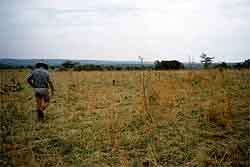 Same at beginning of rainy season. Vigorous greenup after 25-130 mm (1-5") of rain. Bulk of previous year's grass is removed or on the ground. Zietsman farm in Karoi, Zimbabwe, 890 mm (35") rainfall high veld. Jim Howell
 High rainfall tropical savanna in the growing season. Left: grazed at extreme density for very short time through the dormant season. Right: grazed year round at low density. Fenceline contrast on the O'Neill ranch, Chiuhu, Zimbabwe. Jim Howell
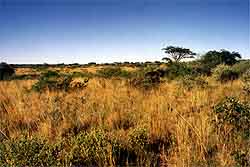 High plant diversity on medium rainfall tropical savanna, dormant season. Sandy Speedy farm, Vryburg, South Africa. Jim Howell
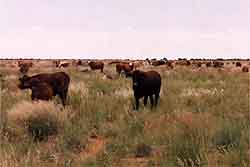 Growing season on medium rainfall tropical savanna. 1000 cattle graze 10 ha (25-acre) paddocks for 1-day grazing periods. Keith Harvey manages this farm near Vryburg. S.A. |
High rainfall savannas -- highly productive
We in holistic management constantly claim that overrest is the main cause of desertification in the brittle environments of the world. I agree with that, but if we simply say that we need to "break the overrest" with high doses of animal impact (through careful grazing planning) and everything will come right, I think we set ourselves up for a lot of disappointment, depending on our environment. In the high rainfall brittle topics, it's easy to see how overrest does indeed create an ecological disaster, and it does so in a short time. It's also easy to observe how maintaining high levels of stock density and intense animal impact will keep the soil covered and keep the carbon and the minerals cycling. Extreme stock densities and very short grazing periods are indeed necessary to cycle the material back to the soil surface as dung and urine or as litter, while simultaneously maintaining acceptable animal performance. My experiences in Africa are that it's nearly impossible to impact this sort of country too much. Minimizing overgrazing will result in more species diversity in the pasture, but overgrazing is of minimal concern relative to overrest. Plant growth is so fast during the rainy season that it's far more challenging to maintain pasture quality than it is to prevent overgrazing of plants. Plants can recover very quickly from a severe grazing as well. The huge bulk of organic material produced every year guarantees an abundant supply of litter-making material. So the focus in these high production environments has to be on maintaining high levels of animal impact, with a lesser focus on minimizing overgrazing and maintaining plant vigor.Low rainfall savannas -- medium productivity
As we move into more semi-arid to arid tropical and subtropical country, this all starts to change. Overrest remains the main villain, but we have to now start to pay a lot more attention to plant vigor. As precipitation becomes less in both quantity and reliability, growing seasons tend to become less abundant, and the amount of time a perennial grass needs to recover from a severe grazing increases. In arid country, more than one complete growing season may be necessary. Additionally, the more arid we get, the greater spaces tend to be between perennial plants, and the more reliant we are on litter to keep the soil covered. If a perennial grass in an arid environment is grazed to a low residual every year, that litter source never has the chance to accumulate. This litter accumulation is extremely important, because it's very difficult for seeds to germinate and seedlings to establish on bare soil in arid environments, and because without the litter, precipitation is largely ineffective due to high evaporation rates off of bare, exposed soil. Because the forages in these environments tend to be much less fibrous than in the high production environments, and because mature soil caps don't develop as readily, maintaining high levels of stock density isn't as crucial. It's still necessary to keep densities high enough to allow for the efficient cycling of organic matter, even levels of plant utilization, and a disturbed soil surface, but just as critical to allow for sufficient recovery periods to enable plants to fully recover from severe defoliation.Temperate steppes -- low productivity
As we get into the temperate steppe environments, this focus on allowing plants to fully recover and grow a source of soil-covering litter becomes even more important. Unlike tropical savanna environments, from high to low rainfall, where the precipitation comes over the course of an intense summer rainy season, steppe environments tend to get, on average, their precipitation spread out over the whole year. A low rainfall tropical savanna that averages 300 mm (12") of rain over four months in the summer is a lot different than a 300 mm (12") mild steppe environment, which averages little bits of precipitation every month of the year. In the savanna, the likelihood of growing grass in the course of a year is a lot greater than in the steppe, because successive rains tend to build on each other. In the steppes, months or years may go by before a good string of rains come in close succession.To ensure plants are recovered and that there is new material to make litter with, recovery periods need to be even longer in the steppe country, up to several years in some cases. Also, just because a plant has gone through a growing season and grown some new material and produced a seedhead doesn't mean it's fully recovered. Until that plant looks as vigorous as a plant of the same species which has had one or more full growing seasons of recovery (and growing in the same soil type and aspect), it is only partially recovered.
Jim Howell
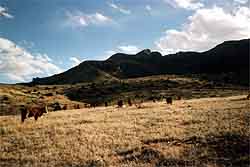 Dormant period on low production, mild temperate steppe. High Lonesome ranch, Lordsburg, New Mexico. Jim Howell
 Cool season annuals growing in big tobosa grass (a native warm season perennial) in March after unusually abundant winter rain. Mild winter temperatures make cool season growth possible, but it is very erratic and unpredictable. High Lonesome. Jim Howell
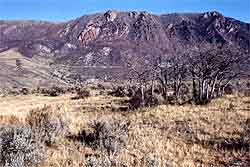 Cold steppe in western Colorado, U.S.A., a semi- to highly brittle area getting 350 mm (14") annual precipitation. Pasture grazed heavily in mid-June during peak growth, photographed in October. Decent summer rain produced only 130-150 mm (5-6") new growth. These plants are not recovered. Jim Howell
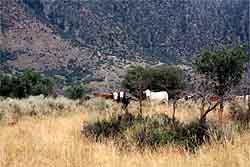 Same as previous, but a paddock cattle didn't move onto until September. This is what fully recovered plants look like here in a pretty good year. Our place near Montrose, Colorado. |
In the steppes, the time required to fully recover between periods of severe grazing may be one to several years. In addition to looking at plant vigor to determine if the plant is fully recovered, we also need to look at amount of standing dead herbage to serve as a source of litter. When a plant with the current season's growth combined with the previous season's dead growth is grazed, the animal will tend to select the new season's leaves, and will push a lot of that older growth to the ground with its muzzle, in addition to its hooves. If the recovery period gets so long that the amount of accumulated older material becomes repulsive to the animal, then that plant is probably approaching the point of being overrested. The excessive material is not only a problem in terms of attracting animals to graze the plant, it is probably also becoming a liability to the plant itself, due to shading of growth points at the plant's base. Again, this takes a long time to develop in low production brittle environments, and only one growing season, or just part of a growing season, in high production environments.
So the animals eventually have to return, because overrest leads to a deteriorated environment here just as it does in the high rainfall, highly productive tropics. Stock densities have to be as high as we can realistically get them and grazing periods need to be as short as possible in order to achieve an even level of forage utilization and well-distributed animal impact. But focusing on creating high animal impact without planning for adequate recovery periods spells disaster in these environments. My experience is that it's initially far easier and more effective to create adequate recovery periods than to try and kill yourself and your animals creating high stock density. As forage volume improves and a source of litter starts to build, it then not only makes more sense to try and create more animal impact, but it's more possible to do because there will be something there to feed the animals. The bigger we can get our ranches, not necessarily as units of ownership but as units of management, and the bigger we can get our herds, the more effectively we'll be able to achieve both high levels of impact combined with adequately long recovery periods.
Planning for these long recovery periods in these low production brittle environments obviously has economic ramifications. I've got some ideas on that, but it'll have to wait for another time. In most cases, I do think it's still economically viable to plan for these long recovery periods, if that's what your monitoring and observations tell you may be needed.
Mediterranean climates -- medium to low productivity
Mediterranean environments have a condensed rainfall pattern like the tropics, but it comes in the cool season instead of the warm season. This makes these climates less productive than tropical areas. Lots of decay takes place during the rainy season due to the nearly perpetually moist soil surface, which is aided by cool temperatures that keep moisture from evaporating rapidly. In the tropics, very hot summer temperatures create much higher evaporation rates, so not as much decay takes at the soil surface or at the base of plants, unless it's an exceptionally wet year. For these reasons, Mediterranean areas typically display less productivity and less brittle characteristics than tropical areas with similar total rainfall.
Joy Livingwell
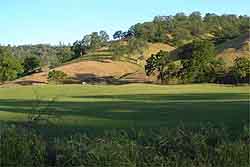 Late spring in northern California, a medium-productivity Mediterranean climate on the edge of semi-brittle and brittle. Rainfall is 300-1800 mm (12-72"), averaging 850 mm (34"), with a 6-month rainless period. Continuous grazing favored annuals (brown hills); native perennials disappeared. Green meadow is planted perennial grass. |
In Mediterranean climates, only perennials stay green during the dry summers. This makes them vulnerable to overgrazing at a time when annuals are dead and therefore unaffected by grazing. Long grazing periods will weaken the perennials and allow annuals to take over, as has happened in places like California.
-- Jim Howell
© 2003
Jim Howell and his wife Daniela run tours of holistically managed farms and ranches around the world. They ranch outside Montrose, Colorado, U.S.A
Posted 6 March 2003
Related articles and links
